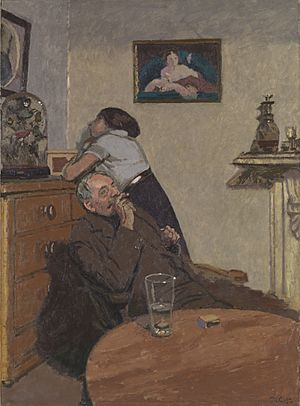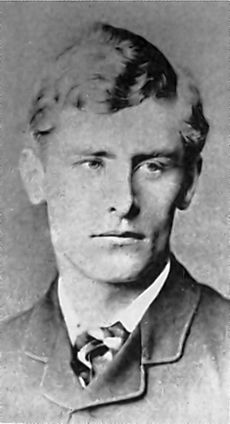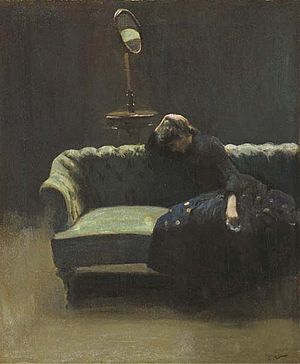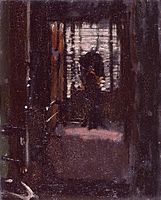Walter Sickert facts for kids
Quick facts for kids
Walter Sickert
RA RBA
|
|
|---|---|

Sickert photographed by George Charles Beresford, 1911
|
|
| Born | 31 May 1860 |
| Died | 22 January 1942 (aged 81) Bath, Somerset, England
|
| Resting place | Church of St Nicholas, Bathampton |
| Nationality | British |
| Alma mater | University College School King's College School |
| Known for | Painting |
|
Notable work
|
The Camden Town Murder Ennui |
| Movement | Post-Impressionism |
| Spouse(s) |
Ellen Cobden
(m. 1885; div. 1899)Christine Angus
(m. 1911; died 1920)Thérèse Lessore
(m. 1926) |
| Elected | Royal Academy Royal Society of British Artists |
Walter Richard Sickert RA RBA (31 May 1860 – 22 January 1942) was a German-born British painter and printmaker who was a member of the Camden Town Group of Post-Impressionist artists in early 20th-century London. He was an important influence on distinctively British styles of avant-garde art in the mid and late 20th century.
Sickert was a cosmopolitan and eccentric who often favoured ordinary people and urban scenes as his subjects. His work includes portraits of well-known personalities and images derived from press photographs. He is considered a prominent figure in the transition from Impressionism to Modernism. Decades after his death, several researchers and theorists suspected Sickert to have been the London-based serial killer Jack the Ripper, but the theory has largely been dismissed.
Contents
Training and early career
Sickert was born in Munich, Germany, on 31 May 1860, the eldest son of Oswald Sickert, a Danish artist, and his English wife, Eleanor Louisa Henry, who was the illegitimate daughter of the astronomer Richard Sheepshanks. In 1868, following the German annexation of Schleswig-Holstein, the family settled in England, where Oswald's work had been recommended by Freiherrin Rebecca von Kreusser to Ralph Nicholson Wornum, who was Keeper of the National Gallery at the time. The family eventually settled in London and obtained British nationality. The young Sickert was sent to University College School from 1870 to 1871, before transferring to King's College School, where he studied until the age of 18. Though he was the son and grandson of painters, he first sought a career as an actor; he appeared in small parts in Sir Henry Irving's company, before taking up the study of art in 1881. After less than a year's attendance at the Slade School, Sickert left to become a pupil of and etching assistant to James Abbott McNeill Whistler. Sickert's earliest paintings were small tonal studies painted alla prima from nature after Whistler's example.
In 1883 he travelled to Paris and met Edgar Degas, whose use of pictorial space and emphasis on drawing would have a powerful effect on Sickert's work. "Degas provided the counterweight to Whistler, and one which was eventually to prove the more significant for Sickert's development." He developed a personal version of Impressionism, favouring sombre colouration. Following Degas' advice, Sickert painted in the studio, working from drawings and memory as an escape from "the tyranny of nature". In 1888 Sickert joined the New English Art Club, a group of French-influenced realist artists. Sickert's first major works, dating from the late 1880s, were portrayals of scenes in London music halls. One of the two paintings he exhibited at the NEAC in April 1888, Katie Lawrence at Gatti's, which portrayed a well known music hall singer of the era, incited controversy "more heated than any other surrounding an English painting in the late 19th century".
In the late 1880s he spent much of his time in France, especially in Dieppe, which he first visited in mid-1885, and where his mistress, and possibly his illegitimate son, lived. During this period Sickert began writing art criticism for various publications, including Herbert Vivian and Stuart Richard Erskine's "The Whirlwind". Between 1894 and 1904 Sickert made a series of visits to Venice, initially focusing on the city's topography; it was during his last painting trip in 1903–04 that, forced indoors by inclement weather, he developed a distinctive approach to the multiple-figure tableau that he further explored on his return to Britain.

Sickert's fascination with urban culture accounted for his acquisition of studios in working-class sections of London, first in Cumberland Market in the 1890s, then in Camden Town in 1905. The latter location provided an event that would secure Sickert's prominence in the realist movement in Britain.
Sickert's best-known work, Ennui (c. 1913), reveals his interest in Victorian narrative genres. The composition, which exists in at least five painted versions and was also made into an etching, depicts a couple in a dingy interior gazing abstractedly into empty space, as though they can no longer communicate with each other.
Just before the First World War he championed the avant-garde artists Lucien Pissarro, Jacob Epstein, Augustus John and Wyndham Lewis. At the same time Sickert founded, with other artists, the Camden Town Group of British painters, named from the district of London in which he lived. This group had been meeting informally since 1905, but was officially established in 1911. It was influenced by Post-Impressionism and Expressionism, but concentrated on scenes of often drab suburban life; Sickert himself said he preferred the kitchen to the drawing room as a scene for paintings.
From 1908 to 1912, and again from 1915 to 1918, he was an influential teacher at Westminster School of Art, where David Bomberg, Wendela Boreel, Mary Godwin and John Doman Turner were among his students. He founded a private art school, Rowlandson House, in the Hampstead Road in 1910. It lasted until 1914; for most of that period its co-principal and chief financial supporter was the painter Sylvia Gosse, a former student of Sickert. He also briefly set up an art school in Manchester where his students included Harry Rutherford.
Late period
After the death of his second wife in 1920, Sickert relocated to Dieppe, where he painted scenes of casinos and café life until his return to London in 1922. In 1924, he was elected an Associate of the Royal Academy (ARA).
In 1926 he suffered an illness, thought to have been a minor stroke. In 1927, he abandoned his first name in favour of his middle name, and thereafter chose to be known as Richard Sickert. His style and subject matter also changed: Sickert stopped drawing, and instead painted from snapshots usually taken by his third wife, Thérèse Lessore, or from news photographs. The photographs were squared up for enlargement and transferred to canvas, with their pencil grids plainly visible in the finished paintings.
Seen by many of his contemporaries as evidence of the artist's decline, Sickert's late works are also his most forward-looking, and prefigure the practices of Chuck Close and Gerhard Richter. Other paintings from Sickert's late period were adapted from illustrations by Victorian artists such as Georgie Bowers and John Gilbert. Sickert, separating these illustrations from their original context and painting them in poster-like colours so that the narrative and spatial intelligibility partly dissolved, called the resulting works his "English Echoes".
Sickert painted an informal portrait of Winston Churchill in about 1927. Churchill's wife Clementine introduced him to Sickert, who had been a friend of her family. The two men got along so well that Churchill, whose hobby was painting, wrote to his wife that "He is really giving me a new lease of life as a painter."
Sickert tutored and mentored students of the East London Group, and exhibited alongside them at The Lefevre Gallery in November 1929.
Sickert made his last etching in 1929.
Sickert was President of the Royal Society of British Artists from 1928 to 1930. He became a Royal Academician (RA) in March 1934 but resigned from the Academy on 9 May 1935 in protest against the president's refusal to support the preservation of Jacob Epstein's sculptural reliefs on the British Medical Association building in the Strand. In the last decade of his life, he depended increasingly on assistants, especially his wife, for the execution of his paintings.
One of Sickert's closest friends and supporters was newspaper baron Lord Beaverbrook, who accumulated the largest single collection of Sickert paintings in the world. This collection, with a private correspondence between Sickert and Beaverbook, is in the Beaverbrook Art Gallery in Fredericton, New Brunswick, Canada. In addition to having painted Beaverbrook, Sickert painted portraits of notables including Gwen Ffrangcon-Davies, Hugh Walpole, Valentine Browne, 6th Earl of Kenmare, and less formal depictions of Aubrey Beardsley, King George V, and Peggy Ashcroft.
Sickert died in Bath, Somerset in 1942, at the age of 81. He had spent much time in the city in his later years, and many of his paintings depict Bath's varied street scenes. He had been married three times: from 1885 until their divorce in 1899 to Ellen Cobden, a daughter of Richard Cobden; from 1911 until her death in 1920 to Christine Angus; and from 1926 until his death to the painter Thérèse Lessore. He is buried in the churchyard of the Church of St Nicholas, Bathampton.
Sickert's sister was Helena Swanwick, a feminist and pacifist active in the women's suffrage movement.
Style and subjects
For his earliest paintings, Sickert followed Whistler's practice of rapid, wet-in-wet execution using very fluid paint. He subsequently adopted a more deliberate procedure of painting pictures in multiple stages, and "attached a great deal of importance to what he called the 'cooking' side of painting". He preferred to paint not from nature but from drawings or, after the mid-1920s, from photographs or from popular prints by Victorian illustrators. After transferring the design to canvas by the use of a grid, Sickert made a rapid underpainting using two colours, which was allowed to dry thoroughly before the final colours were applied. He experimented tirelessly with the details of his method, always with the goal, according to his biographer Wendy Baron, of "paint[ing] quickly, in about two sittings, with the maximum economy and minimum of fuss".
Sickert tended to paint his subjects in series. He is identified particularly with domestic interior scenes, scenes of Venice, music hall and theatre scenes, and portraits. He painted very few still lifes. For his music hall subjects, Sickert often chose complex and ambiguous points of view, so that the spatial relationship between the audience, performer and orchestra becomes confused, as figures gesture into space and others are reflected in mirrors. The isolated rhetorical gestures of singers and actors seem to reach out to no-one in particular, and audience members are portrayed stretching and peering to see things that lie beyond the visible space. This theme of confused or failed communication between people appears frequently in his art. By emphasising the patterns of wallpaper and architectural decorations, Sickert created abstract decorative arabesques and flattened the three-dimensional space. His music hall pictures, like Degas' paintings of dancers and café-concert entertainers, connect the artificiality of art itself to the conventions of theatrical performance and painted backdrops.
Sickert often professed his distaste for what he termed the "beastly" character of thickly textured paint. In an article he wrote for The Fortnightly Review in 1911, he described his reaction to the paintings of Van Gogh: "I execrate his treatment of the instrument I love, these strips of metallic paint that catch the light like so many dyed straws ... my teeth are set on edge". In response to Alfred Wolmark's work he declared that "thick oil-paint is the most undecorative matter in the world".
Nonetheless, Sickert's paintings of the Camden Town Murder series of c. 1906–1909 were painted in heavy impasto and narrow tonal range. The influence of these paintings on successive generations of British artists has been noted in the works of Freud, David Bomberg, Francis Bacon, Frank Auerbach, Howard Hodgkin, and Leon Kossoff.
In the 1910s and 1920s, the dark, gloomy tones of his early paintings gradually brightened, and Sickert juxtaposed unexpected tones with a new boldness in works such as Brighton Pierrots (1915) and Portrait of Victor Lecourt (1921–24). His several self-portraits usually displayed an element of role-playing consistent with his early career as an actor: Lazarus Breaks his Fast (c. 1927) and The Domestic Bully (c. 1935–38) are examples. Sickert's late works display his preference for thinly scrubbed veils of paint, described by Helen Lessore as "a cool colour rapidly brushed over a warm underpainting (or vice versa) on a coarse canvas and in a restricted range allow[ing] the undercoat to 'grin through'".
Sickert insisted on the importance of subject matter in art, saying that "all the greater draughtsmen tell a story", but treated his subjects in a detached manner. Max Kozloff wrote: "How not to say too much seems to have become a matter of utmost laborious concern for Sickert", as evidenced by his paintings' studied lack of finish and "neurasthenic sobriety" of color. According to the painter Frank Auerbach, "Sickert's detachment became increasingly evident in his uninhibited procedures. He made obvious his frequent reliance on snapshots and press photographs, he copied, used and took over the work of other, dead, artists and made extensive use, also, of the services of his assistants who played a large and increasing part in the production of his work."
Jack the Ripper
Sickert took a keen interest in the crimes of Jack the Ripper and believed he had lodged in a room used by the notorious serial killer. He had been told this by his landlady, who suspected a previous lodger who stayed there in 1881. Sickert did a painting of the room in 1905–1907 and titled it Jack the Ripper's Bedroom (Manchester Art Gallery). It shows a dark, melancholy room with most details obscured. It suggests his morbid interest in the subject. There is good evidence he spent most of 1888, the time of the murders, outside the UK.
Although for over 80 years there was no mention of Sickert being a suspect in the Ripper crimes, in the 1970s authors began to explore the idea that Sickert was Jack the Ripper or his accomplice.
In 1976 Stephen Knight, in his book Jack the Ripper: The Final Solution, maintained that Sickert had been forced to become an accomplice in the Ripper murders. Knight's information came from Joseph Gorman, who claimed to be Sickert's illegitimate son. Gorman later admitted that his story was a hoax. From 1989 to 1998 Alan Moore and Eddie Campbell published the graphic novel From Hell, which was based on Stephen Knight's theory. In 1990 Jean Overton Fuller, in her book Sickert and the Ripper Crimes, maintained that Sickert was the killer.
In 2002 crime novelist Patricia Cornwell, in Portrait of a Killer: Jack the Ripper—Case Closed, maintained that Sickert was Jack the Ripper. Cornwell purchased 31 of Sickert's paintings, and some in the art world have said that she destroyed one of them in searching for Sickert's DNA, but Cornwell denies having done this. Cornwell claimed that mitochondrial DNA from one of more than 600 Ripper letters sent to Scotland Yard and mitochondrial DNA from a letter written by Sickert belong to only one percent of the population. In 2017, Cornwell published another book on the subject, Ripper: The Secret Life of Walter Sickert, in which she uncovers what she believes to be further evidence of Sickert's guilt. In 2004 the Oxford Dictionary of National Biography, in its article on Sickert, dismissed any claim that he was Jack the Ripper as "fantasy". In 2005, Matthew Sturgis included a lengthy "Postscript" in his substantial biography of the artist, exploring Cornwell's and others' claims: it begins, "Walter Sickert was not Jack the Ripper". Sickert scholar Richard Shone, reviewing Sturgis's book, refers to "Sturgis's superb demolition of Cornwell" and adds that Sturgis "lays waste the crimewriter's theory with extraordinary conviction."
In 2019, an article in Science, the journal of the American Association for the Advancement of Science, stated that Cornwell's allegation that Sickert was the Ripper was based on a DNA analysis of letters that "many experts believe ... to be fake" and that "another genetic analysis of the letters claimed the murderer could have been a woman".
Personal papers
Walter Sickert's personal papers are held at Islington Local History Centre. Additional papers are held at several other archives, particularly the Tate Gallery Archive. The Walker Art Gallery holds the largest collection of his drawings, a total of 348.
Retrospectives
In 2021–2022, a retrospective exhibition Sickert: A Life in Art at the Walker Art Gallery, Liverpool, displayed around 100 of Sickert's paintings and 200 drawings, claiming to be the largest retrospective of the artist’s work to have been held in the UK for more than 30 years. The art critic Jonathan Jones noted: "This baffling man who was born in Munich in 1860, emigrated to Britain as a child and became one of our greatest and weirdest artists, emerges in this excellent show as even odder than I thought. In that unsettling way of seeing lies his modernity."
From 28 April to 18 September 2022, Tate Britain staged the first major Sickert retrospective at Tate in over 60 years, featuring over 150 of his works from over 70 public and private collections, and claiming to be the most extensive retrospective in almost 30 years. The exhibition was organised in collaboration with the Petit Palais, Paris, where it is expected to be displayed between late 2022 and 2023. Jonathan Jones observed, "This hellishly brilliant exhibition takes you to a place beyond simple moral or political truth. Whatever Sickert was, he was the only British artist of his time who can be as powerful as Munch, Van Gogh or Otto Dix."
See also
 In Spanish: Walter Richard Sickert para niños
In Spanish: Walter Richard Sickert para niños
- Elwin Hawthorne – artist, worked for a period as Sickert's assistant
- Florence Pash – artist, ran a private art school with Sickert in the mid-1890s







